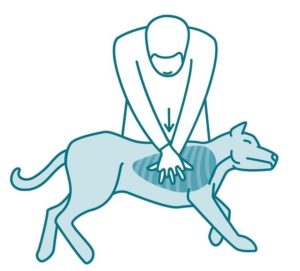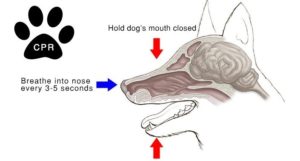How to give your PET CPR
Do you know how to perform CPR on your pet if they begin to show signs of suffering a breathing emergency? Due to the shortage of animal ambulance companies around to pick up your dog or cat, you will always be their first responder. Knowing how and when to perform CPR for your pet could potentially save their life or give you time to reach a local Vet or Animal E.R. According to the American Red Cross, the following are the active steps to take if you notice your pet is suffering from a breathing or cardiac emergency.
- Check for breathing and a heartbeat

- Check to see if the pet is breathing and check for a heartbeat. If you do not see your pet’s chest moving and cannot find a heartbeat, begin CPR with chest compressions.
- Give chest compressions
- Small Animals: for cats, small dogs and deep chested dogs, place the heel of one of your hands directly over the pet’s heart and place your other hand directly over the first hand.
- Deep Chested Dogs: for deep chested dogs, place the heel of one hand over the widest part of the chest and place your other hand directly over the first hand.
- Barrel Chested Dogs: for barrel chested dogs, place the dog on its back, place one hand over the widest part of the sternum, and place your other hand directly over the first hand. Lock your elbows and make sure your shoulders are directly above your hands.
Then, push hard and push fast at a rate of 100-120 compressions per minute, compressing (HOW DEEP???) 1/3 to 1/2 the width of your pet’s chest. Make sure the chest comes back fully (recoils) before compressing again. Perform 30 chest compressions followed by two rescue breaths
- Give rescue breaths:
- Gently close the pet’s mouth and extend the pet’s neck to open the airway. Cover your pet’s nose with your mouth and exhale until you see the pet’s chest rise. Give a second rescue breath.
 Continue CPR Process:
Continue CPR Process:
- Continue giving CPR with a cycle of 30 chest compressions and 2 rescue breaths until your dog or cat begins breathing again on its own.
- Check again for breathing and a heartbeat:
- Briefly check for breathing and a heartbeat every 2 minutes.
- Get Help:
- Continue CPR until you reach a veterinary hospital.
What should I do with this information?
Let’s face the facts. It is close to impossible to think straight in an emergency situation, let alone remember steps from an article you read one time on that insurance company’s website.
Print out the steps to the CPR process, laminate it (if you want to get fancy with it) and hang it near pet food storage or inside the common storage space closet for easy access.
Locate the closest Animal ER or animal vet in your area. Write or save their contact information phone and address listed either on this emergency form or in your phone labeled ANIMAL E.R., PET HOSPITAL or however you want to remember it.
For more information regarding Animal CPR log onto Red Cross or sign up for a local Pet CPR class in your area.

 Continue CPR Process:
Continue CPR Process: